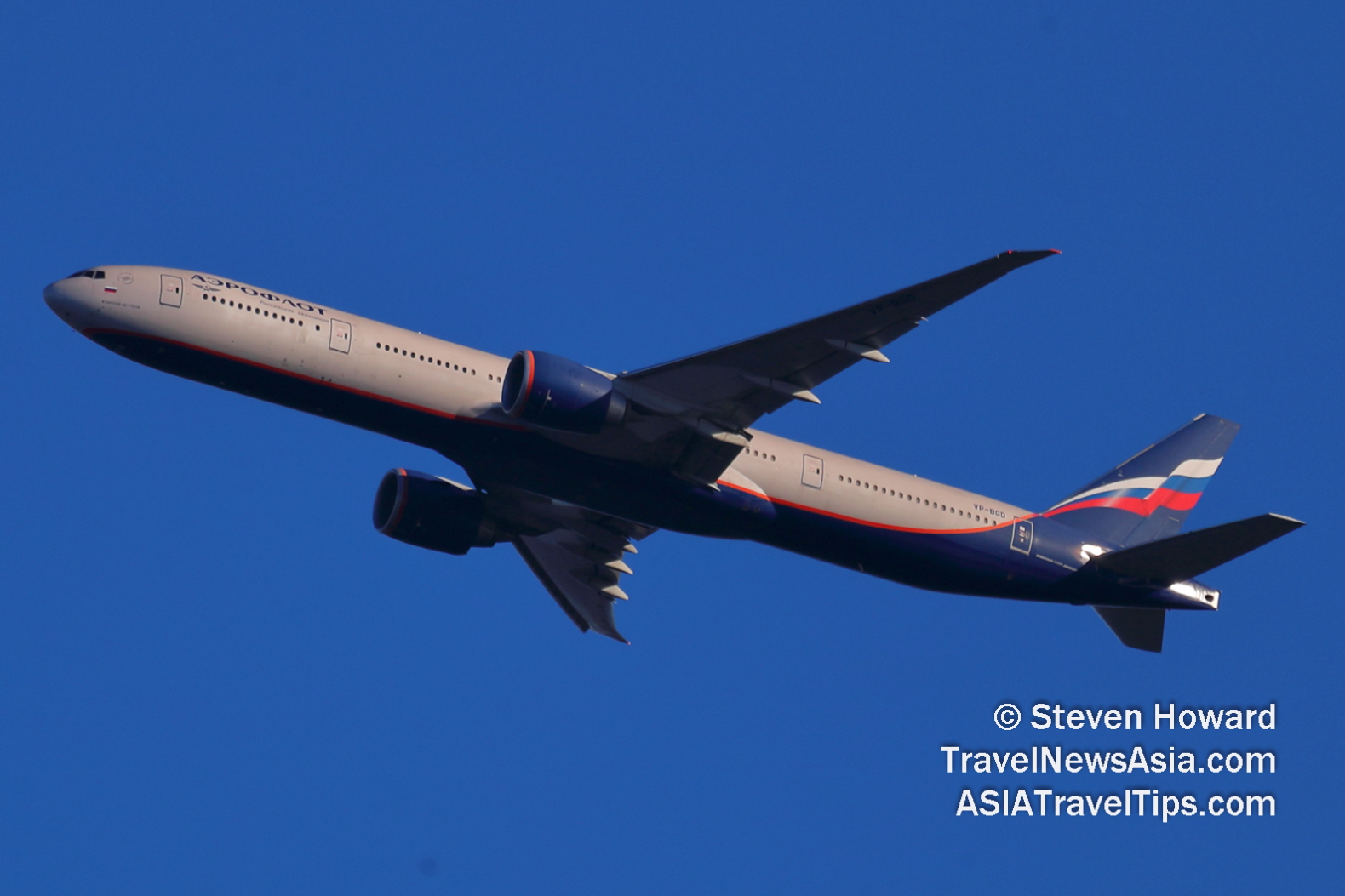|
(26 Jan 2022)
IATA's full-year global
passenger traffic results for 2021 show that demand, measured in revenue
passenger kilometers (RPKs), fell by 58.4% compared to the full
year of 2019, an improvement compared to 2020,
when full year RPKs were down 65.8% versus 2019.
International passenger demand in 2021 was 75.5%
below 2019 levels. Capacity, measured in available seat
kilometers or (ASKs), declined 65.3% and load factor fell 24
percentage points to 58%.
Domestic demand in 2021 was down 28.2% compared to
2019. Capacity contracted by 19.2% and load factor dropped 9.3
percentage points to 74.3%.
Total traffic for the month of December 2021 was
45.1% below the same month in 2019, improved from the 47%
contraction in November, as monthly demand continued to recover
despite concerns over Omicron. Capacity was down 37.6% and load
factor fell 9.8 percentage points to 72.3%.

Aeroflot Boeing 777 reg: VP-BGD. Picture by Steven Howard of TravelNewsAsia.com
Omicron travel
restrictions slowed the recovery in international demand by about
two weeks in December. International demand has been recovering at
a pace of about four percentage points/month compared to 2019.
Without Omicron, we would have expected international demand for
the month of December to improve to around 56.5% below 2019
levels. Instead, volumes rose marginally to 58.4% below 2019 from
-60.5% in November.
Willie Walsh, IATA�s Director General, said,
�Overall travel demand strengthened in 2021. That trend continued
into December despite travel restrictions in the face of Omicron.
That says a lot about the strength of passenger confidence and the
desire to travel. The challenge for 2022 is to reinforce that
confidence by normalizing travel. While international travel
remains far from normal in many parts of the world, there is
momentum in the right direction. Last week, France and Switzerland
announced significant easing of measures. And yesterday the UK
removed all testing requirements for vaccinated travelers. We hope
others will follow their important lead, particularly in Asia
where several key markets remain in virtual isolation.�
Asia-Pacific airlines� full-year international
traffic plunged 93.2% in 2021 compared to 2019, which was the
deepest decline for any region. It fell 87.5% in the month of
December, a bit better than the 89.8% decline in November. Full
year capacity was down 84.9% compared to 2019. Load factor fell
44.3 percentage points to 36.5%.
European carriers saw a 67.6% traffic decline in
2021 versus 2019. Capacity fell 57.4% and load factor decreased
20.6 percentage points to 65%. For the month of December,
traffic slid 41.5% compared to December 2019, an improvement over
the 43.5% year-to-year decline in November.
Middle Eastern airlines� annual passenger volumes
in 2021 were 71.6% below 2019. Annual capacity fell 57.7% and load
factor dropped 25.1 percentage points to 51.1%. December�s traffic
was down 51.2% compared to December 2019, a solid pick-up from a
54.3% drop in November.
North American airlines� full year traffic fell
65.6% compared to 2019. Capacity dropped 52.0%, and load factor
sank 23.8 percentage points to 60.2%. December demand was down
41.7% compared to the same month a year-ago, a pick-up over a
44.6% drop in November.
Latin American airlines had a 66.9% full year
traffic decline compared to 2019. Capacity fell 62.2% and load
factor dropped 10.2 percentage points to 72.6%, the highest among
regions. Traffic fell 40.4% for the month of December compared to
December 2019, significantly bettering the 47.3% decline in
November.
African airlines� international traffic fell 65.2%
last year compared to 2019, which was the best performance among
regions. Capacity dropped 56.7%, and load factor sank 14.1
percentage points to 57.3%. Demand for the month of December was
60.5% below the year-ago period, a deterioration from the 56.5%
decline in November, owing to the impact of government travel
restrictions in response to Omicron.
Domestic Passenger Markets
China�s domestic passenger traffic fell 24.4% in
2021 compared to 2019. It was down 39.6% for the month of December
versus December 2019, which was an improvement compared to a 50.9%
decline in November.
Russia�s domestic traffic rose 24.2% for the full
year, and 23.2% for the month of December, an acceleration over
the 17.5% rise in November. Russia was the only market to see
growth in RPKs in 2021 compared to 2019.
�As COVID19 continues to evolve from the pandemic
to endemic stage, it is past time for governments to evolve their
responses away from travel restrictions that repeatedly have been
shown to be ineffective in preventing the spread of the disease,
but which inflict enormous harm on lives and economies. A new
year�s resolution for governments should be to focus on building
population immunity and stop placing travel barriers in the way of
a return to normality,� said Walsh.
|
Headlines: |
|
|
